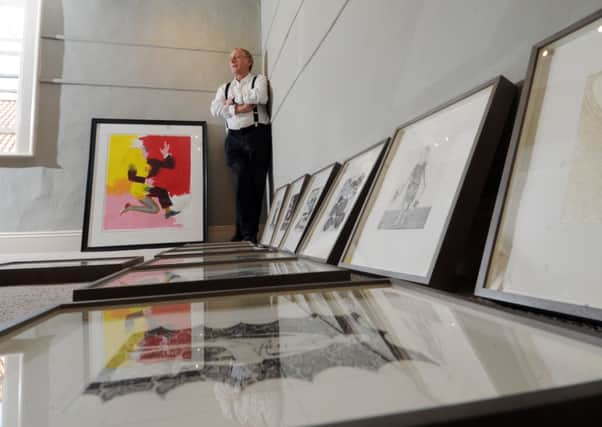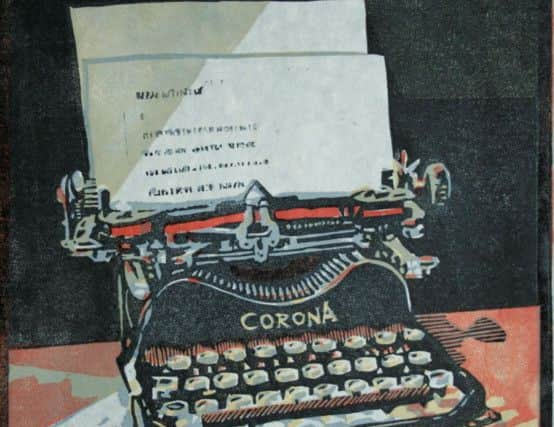Frame is the spur


The sun has yet to rise on the east coast of Yorkshire as the wind whips the rigging and the sea foam slaps the sides of the hull. A tangle of fishing nets, not to be used on this day’s voyage, lies discarded on the deck. Meanwhile, in London, the 246th annual Summer Exhibition hangs in the Royal Academy, a quiet lull before another few thousand visitors flood through the doors.
The two scenes are connected by the unassuming Yorkshireman Norman Ackroyd. You might have seen him had you happened to find yourself at Whitby’s harbour at 4am one day a couple of months ago or visited the Royal Academy in the 26 years since he was elected a Royal Academician.
Advertisement
Hide AdAdvertisement
Hide AdWhile now based in London the printmaker has recently been back in his native Yorkshire to curate The Royal Academy of Arts in Yorkshire, a hand-picked selection of works from this year’s Summer Exhibition at his friend and long-time supporter John Bell’s Thirsk-based Zillah Bell Gallery.


“The exhibition came about because the space above their main gallery became free so they converted it into a really beautiful space which was specially designed to hang prints,” says the artist, surrounded by some 90 sketches from several recent boat trips and walks along the Yorkshire coastline at his Bermondsey studio.
“I thought, well wouldn’t it be wonderful to bring some terrific prints up into the heart of Yorkshire, and then, because last year I was in charge of the Summer Exhibition at the Royal Academy, I thought I could do my own edited smaller version, bringing the best of them to the heart of Yorkshire.” This translates as aquatints, linocuts, screenprints, woodcuts and etchings from the likes of acclaimed Royal Academicians Allen Jones, Howard Phipps, Dame Elizabeth Blackadder and Turner Prize nominee Ian Davenport.
Ackroyd has been on the Summer Exhibition hanging committee several times. While only about 10 per cent of the work which appeared in the Royal Academy’s print rooms is now on display in Thirsk his method remains the same.
Advertisement
Hide AdAdvertisement
Hide Ad“I lay everything out propped against the wall and I move it around and around until I see the juxtapositions that I like.”
The new upstairs gallery is made up of several rooms knocked together, affording a natural “rhythm” to the exhibition. Perhaps most striking is that for every monochrome etching of a remote landscape reflective of Ackroyd’s own work, there are several more which look nothing like it. His good friends Peter Freeth and Chris Orr are represented – “I think we’re all focused on our own thing and we’re very different but we do encourage each other” – and the range of subjects includes colourful dancers, nudes, abstract forms and animals.
Ackroyd’s distinctive etchings of seascapes and looming cliffs do not feature as he’s bringing new etchings, the result of those 4am trips on fishing boats between Saltburn and Flamborough, to Zillah Bell in November when The Royal Academy of Arts in Yorkshire closes.
He spent the entire weekend before we speak immersing himself in their creation, etching designs into copper plates and using acid washes to create the prints. “Sometimes I take the plates with me and work them direct, but if I can come back and get straight into it, then I’ve got all the freshness in my head and I can work that way as well… it’s very exciting but very tiring.”
Advertisement
Hide AdAdvertisement
Hide AdHe tends to find people with boats, who can take him to the “privileged positions”, in local pubs. This time he chartered a boat for two days, starting out at 4am and working up to 14 hours each day across several books of watercolours.
Nature inspires Ackroyd to make art and, despite it taking until middle age to earn a real living from it, he never considered doing anything else. A surprise perhaps, for the son of a butcher growing up in 1940s Leeds, but Ackroyd draws comparisons between the two jobs.
“My dad was a great craftsman. He went blind after he retired, but he still used to help one or two of his apprentices in the shop at busy times. I’ve seen him cut a sheep into joints just by feel – he could do it blindfold.”
Perhaps he could do the same? “I don’t think I could, although there is the method of staring at the landscape and then putting a blindfold on and drawing,” he says. “The great de Kooning would just sit and stare at the model for a quarter of an hour, and then put a blindfold on and start drawing and there is a lot in that. I found it at St Kilda; the great stacks imprinted on my retina. I would wake up in the morning and with my eyes still closed I could bring it all back. I could probably draw it from what I remembered.”
Advertisement
Hide AdAdvertisement
Hide AdHe has happy memories of growing up in Leeds, particularly bike rides to Malham, but like his friend David Hockney, he left Yorkshire after graduating from Leeds College of Art.
He says: “Memories of childhood are always happy but it was incredibly austere. It was just after the war. Both my brothers had to do national service, I luckily got out of it by getting into the Royal College of Art and by the time I’d finished at the Royal College the war had finished. Hockney didn’t, he had to do his national service. The country was on its uppers financially and Leeds was just one wall of soot, all the factory chimneys were going and of course the trains were still steam trains and when it snowed the snow would be grey by lunchtime.”
Ackroyd briefly moved to America but became “homesick for Britain”. Proximity to the Royal Academy and airports for his travels keeps him in London but he still considers himself “very much a Yorkshireman” and returns often.
“I always love it when I get there and the familiarity of where I’m really from, but it’s only two hours 10 minutes to Thirsk from King’s Cross… Yorkshire’s just down the road for me.”
• The Royal Academy of Arts in Yorkshire, Zillah Bell Gallery, Thirsk, to November 1. www.zillahbellgallery.co.uk